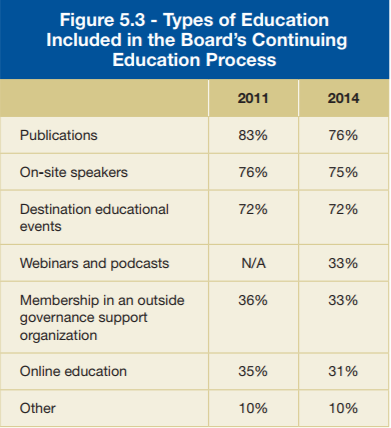Part 1 of 3
Boards and CEOs universally agree on the value and importance of educating board members – the team responsible for making policies and keeping the organization on course. But how do you keep topics interesting, imaginative, recurring and effective?
Unfortunately, the agenda for new board member orientation remains largely unchanged despite our continually evolving healthcare industry. Sometimes new board members dive into a sea of uncertainty and ignorance by default. For example, they may not know the intricacies of the healthcare industry, the market, or even the community (if they live in a different city).

According to the American Hospital Association’s Center for Healthcare Governance “2014 National Healthcare Governance Survey Report,” nearly all types of board education declined from 2011 to 2014. (See Figure 5.3.) Refreshingly, there was a spike in webinars and podcasts, which may be sources of reallocation.
For a board to make evidence-based decisions, it must be well-educated. This is an ongoing process.
At Practical Governance Group, we believe board education should include four parts:
- New board member orientation
- Continuing education at regular board meetings
- Continuing education via publications, webinars and podcasts
- Board retreats
New board member orientation
In this article, we’ll tackle orientation for new board members. While nearly all hospitals and health systems orient their new trustees, crash courses vary. Let’s walk through basic orientations, as well as what some organizations do to welcome (and engulf) their new arrivals.
Duration
Unless your organizational structure is uncharacteristically simple, orienting a new board member in one day is synonymous to a “brain dump.” You provide a tsunami of information, but may sacrifice retention.
Instead, board education should be multifaceted and preserved over three or four half-day sessions. One organization we know holds a 12-hour orientation over three days.
Agenda
When planning orientation for new board members, consider the below.
Overviews of:
- The healthcare industry.
- Emphasize service-area trends.
- Include a business healthcare glossary.
- Highlight current legal issues; include a summary of key federal regulations and law (e.g., compliance).
- Your organization.
- Include the strategic plan, most recent annual report and organizational charts.
- Disclose financial information via the most recent budget or financial indicators report.
- Provide insight on the medical staff (e.g., credentialing documents).
- Include information on quality assurance and/or accreditation.
- Consider adding promotional or marketing materials and links to social media sites.
- The board.
- Include bylaws and job descriptions for board members and officers.
- Discuss current matters and provide any documents that address key issues the board is considering.
- Governance.
- Highlight legal responsibilities and duties of each board member.
- Consider using educational materials from firms that specialize in governance. For example, new trustees who are physicians may need more instruction on business conflicts of interest and interpreting financial statements.
One-on-one meetings
Most organizations provide one-on-one meetings with the CEO, the Board Chair and/or senior leadership team. These comfortable meetings highlight the importance of the board member’s involvement and are especially beneficial to a trustee who is new to healthcare.
Sometimes new board members hesitate to ask certain questions at their first board meeting. These one-on-one encounters offer an ideal platform for such inquiries.
Site tours
Include tours of your campus(es) and facilities.
Mentoring
Only about a quarter of healthcare organizations surveyed* paired a new trustee with a seasoned board member. Existing trustees not only offer deepened insight on board issues, they also shed light on behavioral competencies and group dynamics.
Shadowing
Few healthcare organizations (about 3 percent) offer new board members the opportunity to shadow a clinician. This option helps orient new trustees who aren’t familiar with healthcare. It also offers experiential insight from a clinician’s vantage point. As a value-add, this relationship building (especially with a physician champion) not only benefits the new trustee, but the board as a whole – long term.
There’s nothing like a warm welcome. While most organizations have basic orientation down to a science, consider customizing your offerings to your audience. Having a strong orientation program sets the stage to prepare new board members with the skills, specific knowledge and contacts they need to make tough, high-stakes decisions.
* 2014 National Healthcare Governance Survey (Rep.). (2014). Retrieved January 25, 2018, from AHA Center for Healthcare Governance website: http://trustees.aha.org/envtrends/Governance-Survey-Report-update.pdf
Christine Leon, MBA, is Executive Director of Practical Governance Group. With more than 20 years of experience in healthcare communications and a passion for education, she leads the firm’s on-site and e-learning governance program. Reach her at 904-606-5744 or cleon@pgghealthcare.com.

